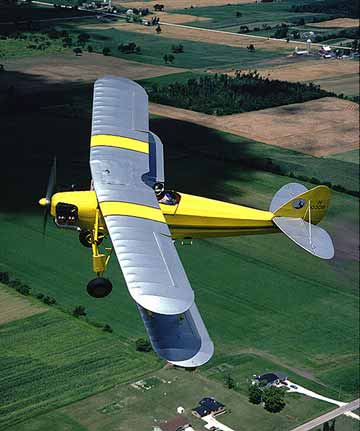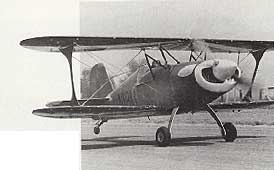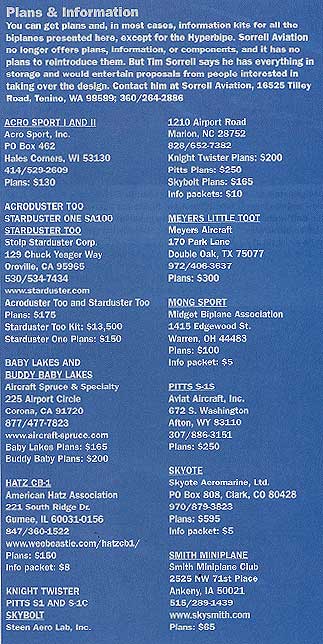Page Two
The Second Biplane Generation
By the late 1960's and early '70's it was obvious that even though
we were seeing lots of new, seriously fast, cross-country monoplanes
entering sport aviation, the biplane still held the hearts of many.
New designs came on the scene, most of which are still with us
in plans-form, if not in pre-welded components.
 |
Skyote (see
airbum.com pirep)
A light, wonderfully fragile looking little kite of an airplane, the Skyote was
full of surprises. Professionally designed, its double swept-back wings used
an aluminum structure while the fuselage was a fine example of finite-element
analysis. Pete Bartoe purposely designed the airplane to have a period look,
which it's out-rigger gear definitely gives it. It's flight characteristics
are amazingly like a Buecker Jungmiester. Very well balanced and quick, the
airplane does credible aerobatics on only 85-115 horsepower. It touches down
at a fast walk, but it's narrow gear and high center of gravity keep the pilot's
feet awake. It's not difficult but does ask that the pilot mind the store. |
 |
Acroduster
After Lou Stolp sold Starduster Corporation, they designed both a single place
and two-place aircraft designed to be much more aerobatic than the Starduster
One and Too. The Acroduster One has an aluminum fuselage which borrows heavily
on the Midget Mustang for structure. It was designed to give the Pitts S-1S
some competition and it comes close, although, with its spring steel gear,
it's much easier to land. The Acroduster Two, is usually seen with much larger
engines and it's a real hot rod. Once on the runway, it is well behaved,
but it comes across the fence faster than some of the others. |
 |
Baby Lakes (see
airbum.com pirep)
Barney Oldfield's Baby Lakes is more "baby" than 'Lakes" and is
probably the smallest biplane for which support is still readily available (although
Steen AeroLab has Knight Twister drawings available). The "Baby"
was designed specifically to give outstanding fun and aerobatic flight on a
minimum of horsepower. It is fine with 65 hp, good with 85 hp, and out-standing
with anything bigger than a C-90, which is probably the optimal engine. A tall
pilot is going to stick out in the breeze, but most will find it a comfortable
size. Kept light, the approach speeds are in the Aeronca Champ range although
it is quicker on the runway. Construction, like the rest of the design, was
aimed at economy. A two-place follow-on, the Buddy Baby, with unique, canoe-like
seating is also available. |
|
Acro-Sport I (see
airbum.com pirep)
The Acro Sport One is actually an aerobatic derivative of Paul Poberezny's EAA
biplane and shares that airplane's ease of construction and handling. Larger
than most single place biplanes, it is Citabria-simple on the runway and
can be handled by most low-time tailwheel pilots. Although it probably flies
best when kept light with an 0-200, most are seen with up to 180 hp at which
point it is a real tiger, albeit, a gentle one. With its Hershey bar wings,
construction is absolutely traditional and simple. The fuselage also exhibits
a lot of thought given to the first time builder. |
 |
Starduster Too ( (see
airbum.com pirep)
Lou Stolp carried the wonderful lines of his single place airplane over to the
Starduster Too. It was the first two-place biplane available to the homebuilt
market and, as such, was built by the hundreds. The lowest power normally used
is 150 hp which makes the airplane a gentle Sunday afternoon flyer. 260 hp Too's
are quite common and they also fly on Sunday afternoon, but everything goes by
much faster. Stolp never designed the airplane for serious aerobatics, although
it will easily do the loop/roll/spin variety. The construction details are identical
to the single place airplane. Its manners on the runway are a direct reflection
of how much the airplane weighs as that changes the touchdown speed so much.
Normally, it is a straight forward landing airplane with only moderate tailwheel
finesse required. |
|
Hyperbipe
The Hyperbipe holds the record as being the only negative-stagger, two-place,
side-by-side, high-speed, cabin biplane available to the homebuilder. At
155-165 mph, it is a terrifically useful airplane. Normally seen using 200
hp with a constant speed prop, the airplane will also do practically any
aerobatics you'd attempt in a two-place Pitts, just not quite as well. It
has a few distinct characteristics, when doing aerobatics, which are probably
the result of the square fuselage shape. These, however, are minor and take
very little getting used to. On the ground, its tapered rod gear makes it
a pussy cat that really knows how to growl on takeoff. The fuselage truss
is welded square tube which are available from the factory. |
|
Hatz
The archaic little Hatz sets aircraft design back about fifty years but moves
fun-aviating ahead into the next millennium. The Hatz might be considered
the Cub of the biplane clan, since it is probably the all-round easiest landing
airplane with two wings as well as being one of the slowest. It was designed
to be slow speed fun and it has succeeded admirably. It has also succeeded
in making a modern antique available to the homebuilder. Because of its larger-than-your-average-
homebuilt size, the Hatz is a very simple, but fairly large project. Nothing
in the airplane is more complicated than it would have been in, say, 1928,
but there's a lot of it. It'll fly with just about any engine you bolt on
it, but 115 hp seems about the bottom of the practical limits. |
|
Skybolt (see
airbum.com pirep)
It's a tribute to LaMar Steen that his early 1970's design is more popular now
than ever. Larger than a two-place Pitts by nearly four feet, the airplane
still gives near Pitts-like aerobatic handling (if built strictly to plans)
with Citabria-like landing characteristics. It's cockpit is large enough
to swallow even the long of everything and are built with every variation
of canopy imaginable. Incidentally, a canopy lowers the drag on the airplane
so much it flattens the approach profile. For some reason, many builders
feel they need to jack the tail up on a tall tailwheel for better visibility.
This only makes the airplane land faster. The top wing is one piece, ala
Pitts, and construction is greatly simplified by the availability of builder-support
and pre-made components. |
|
Acro-Sport II
Paul's evolving of the Acro Sport One to a two-place airplane worked out better
than most such projects do. The two-place airplane is quite light for its
size (if the builder does his part) and the construction is as simple as
the single-place airplane. Takeoff and landing is at least as easy as the
Skybolt which means it's one of the easiest. |
|
Eagle
The Christen/Aviat Eagle cut a huge swath through the homebuilt movement at its
introduction and still continues to do so. Frank Christensen doesn't do things
half way and the Eagle is testament to that. Aviat Aircraft, Inc. has continued
Christensen's fetish with doing it right. If ever there was an orgy of mechanical
detail work, the Eagle and everything surrounding it is it. Not available
in plans form, the airplane is the ultimate model airplane with every aspect
of kit assembly covered in detailed assembly books. Such a degree of development,
however, doesn't come cheap and the Eagle is probably the most expensive
homebuilt biplane. It is also the most comfortable, and, considering its
performance, one of the easiest to land. It's spring steel gear will tolerate
a surprising number of pilot mistakes. This is good, because, once wings-level
over the runway, a lot of asphalt disappears. Like the Pitts, the Eagle is
pretty blind. This however, is just something to be worked around. |
|
